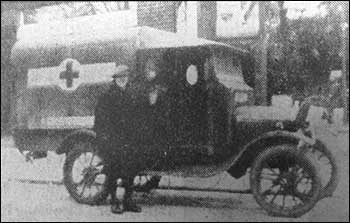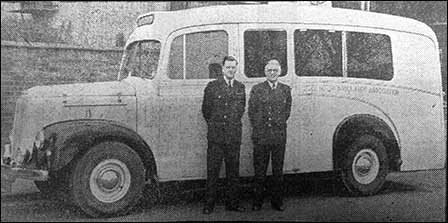Rushden Echo, 18th August 1916, transcribed by Kay Collins
Accident—Mr Charles Hardwick, of 54 Oakley-road, Rushden, has met with a rather nasty accident. On Friday evening last he went to the Irchester-road garden fields and, in stooping to gather some peas, he somehow dislocated his hip, giving it a nasty twist at the joint. He was picked up by Mr Mayhew, of Moor-road, and others, and conveyed home in a motor car by Mr Joseph Knight, whose house is near the garden fields. Dr Baker attended the injured gentleman and ordered his removal to the Northampton hospital the next morning. First-class Sergt. Prigmore and Pte Alec Swindall, of the Rushden St John Ambulance took Mr Hardwick to the station on Saturday morning on a wheel litter and accompanied him in the guard’s can of the train. Mr Hardwick’s wife and mother have both paid separate visits to the hospital and report that the patient is progressing fairly well.
|
Rushden Echo, 23rd February 1923, transcribed by Kay Collins
Staff-Sergt. Prigmore and Pte. W Burgess, of the Rushden St. John Ambulance Division, attended the funeral of the late Mr Walden at Irchester on Monday. Deceased was sergeant in the Irchester St. John Ambulance Division.
|
|
Rushden Echo, 29th June 1928, transcribed by Kay Collins
Rushden Scouts as Stretcher Cases
Ambulance Field Operation at Irchester – A Real Wound Turns Up
A further step in the direction of schooling juvenile organisations in ambulance work, and thus securing a natural recruitment for the St John Ambulance Brigade, was taken in the Wellingborough and Rushden district on Saturday. The uneven ground round the ironstone workings at Irchester, near the Rushden Wellingborough-road, was the scene of field operations which had been postponed a fortnight ago on account of the bad weather.
Under the direction of Corps Supt J Marshall Bailey, M.C., of Rushden, and other officers, the members of the Wellingborough Corps of the St John Ambulance collected the “wounded” who were Boy Scouts from Rushden and other places from the ironstone workings. The “wounded” were posted out with labels to indicate their injuries, and the stretcher parties, each in charge of an N.C.O., on reaching them, applied the necessary first aid treatment. They were then conveyed to Poplar Barn, where an advanced dressing station had been arranged, and from there motor ambulances rapidly conveyed then to the “casualty clearing station,” at Chester House. The C.C.S., in charge of Lady Corps Supt. Miss Smith, was fitted out, and a staff of nursing sisters and their officers were ready to deal with anything.
Dr J Arthur, of Wellingborough, and Dr D G Greenfield, of Rushden, “attended” the “wounded” as they were brought in. The “casualties,” all having been cleared, the stretcher bearers gathered at Chester House, where the doctors addressed the men and nurses, complimenting all on the excellent arrangement and carrying out of the scheme.
During the operations one of the Scouts received a real blow on the head and had to be properly attended to, but happily there was no serious hurt. The injured lad, Scout Bob Richardson, of Pemberton-street, Rushden, was cut on the head by a stone. Corpl. Harris and Privates Denton, Ekins and Warr, all of Rushden, dressed his wound, and at the “hospital” he was attended by Mr Greenfield and the Nursing Sisters. Corpl Sparrow (Wellingborough) received a slight head wound while unloading a van, and he also had expert attention. It was a privilege to be really wounded on such a day.
Ambulance men taking part were from the Rushden, Higham Ferrers, Irthlingborough, Finedon, and Wellingborough, and the Nursing Sisters were from all those places and from Irchester as well. The Rushden Boy Scouts were under Scoutmaster Houghton and they, with the Ambulance Cadets from Irthlingborough, made a total of 50 “patients.” The land for the proposed battlefield was kindly lent by Mr L Parsons, of Irchester, and the Dutch barn for the hospital by Mr Newton Whitworth.
Dr Greenfield said that the smart treatment of “fractures” was the feature of a good day’s work. A case of a supposed wound in the back, difficult to treat, had been most efficiently attended to.
|
|
 |
|
We have this photograph with no information. Please can you help?
|
|
|
| Rushden Echo & Argus, 22nd January 1932, transcribed by Kay Collins
Members of the Rushden St John Ambulance Brigade attended the funeral of the late Ald. W Harvey Reeves, O.B.E., D.L., J.P., at Northampton on Saturday, under Divisional Supt. G W Timpson. The Rushden Nursing Division were under Divisional Supt. Miss W M Clipson and Ambulance Officer Miss M Priestley, Ambulance officer Miss R Tailby was unable to attend, owing to illness.
|
Extract from a longer article 1941
Charles Edmond Ekins, the eldest son, is busy in the Royal Naval Sick Berth Reserve, having been called up at the outbreak of war. Only a few weeks ago he received the Long Service Medal of the St. John Ambulance Brigade. |
|
Rushden Echo & Argus, 16th September 1949
“New Blood” or Become Extinct
A “Desperate” shortage of members was reported at the annual meeting of Rushden Division of the St John Ambulance Brigade, which now has only twenty-four members compared with fifty before the war. [part of a longer article]
|
|
| The Rushden Echo and Argus, 5th March 1954, transcribed by Jim Hollis
They changed gear by pedal in those days
How would you like to ride to hospital in the ancient ambulance pictured below?
Thirty-four years can make a lot of difference, and the modern generation may find it hard to believe that the quaint-looking ambulance was welcomed by Rushden as “the latest” in 1920. The vehicle loaned by the joint Red Cross and St. John organisation, served Rushden, Higham Ferrers and Raunds, taking local patients to Northampton Hospital.
Mr. A. Prigmore was transport officer, and Mr. Cyril Leeding – who sent in the old picture – one of the drivers.
|
 |
 |
|
The second picture, for contrast, shows Rushden’s newest ambulance, with Mr. C. C. Woods, the chief transport officer, and Mr. Frank Burton.
Mr. Malcolm Boyd, secretary of the Rushden and District Motor Ambulance Association, told a reporter that in 1921 40 patients were carried. The mileage was 1,670.
Last year the Rushden-based ambulance, serving a large area on behalf of the hospital authorities, carried 3,410 patients. The mileage was 46,141.
The association’s expenditure has risen from £325 to £3,000. Two full time drivers are now employed.
The old ambulance was a Model T Ford. Altogether ten million Model T vehicles were manufactured. They had no gear levers – a change of gear was effected by pedals.
|
|
Rushden Echo & Argus, 20th February 1948, transcribed by Kay Collins
Ambulance Officer Gets Gift - Rushden Presentation
St. John Nursing Sisters and Cadets from the district converged on the Rushden Division's newly decorated and reopened headquarters on Saturday afternoon.
They witnessed a presentation to their late Corps Supt., Mrs. B. Stephenson, of Wellingborough.
The presentation of an electric clock was made on behalf of the Corps by the County Supt., Mrs. D. Gibbons, of Rothwell, and a pot of daffodils by a Rushden cadet, Margaret Mepham.
A welcome was extended to the visitors by Div. Supt. Miss M. Haddon, S.S. St. J., of the Higham Ferrers Division, whose members were "co-hostess" with the Rushden Division.
Div. Supt. Miss W. M. Clipson, S.S. St. J., of Rushden, addressing Mrs. Stephenson, said: "Our main object this afternoon is to say 'Thank you' for all the great help you have given to each one of us."
War Work
In making the presentation, Mrs. Gibbons spoke of the tremendous amount of work Mrs. Stephenson had done during the war years, and made mention of the fact that she had retired for health reasons.
"I know she will always keep a motherly eye on you all," she added.
Mrs. Stephenson, in acknowledging the gift, said she had something else they had always given her voluntarily—the glow of friendship.
"You were always so helpful and friendly from the beginning" she said, "and I always enjoyed coming out to you during the war years. I only wish I had done more to bring you all together more often—it is good for the Divisions to meet and 'grizzle' together, for it is true you all have the same setbacks."
In conclusion, Mrs. Stephenson said she was still living in the district, and if she could ever do anything for the Corps she would do it.
Be Tolerant
Other tributes were paid by the County Cadet Officer, Miss Grant Lawson, of Cottesbrooke, and Corps Supt. Capt. J. Marshall Bailey, M.C., M.B.E.
Miss Grant Lawson urged the cadets to join the adult divisions, and asked the seniors to be tolerant of youthful wiles.
Miss Clipson referred to the presence of the Div. Surgeon, Dr. D. Pickard, and said it was one of their hopes that one day they would have their own lady surgeon in uniform.
Among other representatives from Wellingborough Headquarters, Finedon, Irchester, Bozeat and Earls Barton were the Corps secretaries, Miss I. Poskitt and Mr. E. Hobbs.
Apologies for absence were received from Wollaston, Raunds and Irthlingborough.
Mrs. Stephenson, who was Corps Supt. from 1943, retired at the end of last year.
|
Rushden Echo and Argus, 20th January 1950, transcribed by Kay Collins
Ambulance Man Asks For 'New Blood'
An urgent plea for new recruits, to bring new blood into the St. John Ambulance Brigade, was made by Corps Supt. J. M. Bailey, with the comment that Rushden was never appealed to in vain, at the annual dinner of Rushden Division on Saturday evening.
"Numbers are an indication of enthusiasm and efficiency, but a division should not be judged by numbers alone," said Mr. Bailey. "The enthusiasm of the Rushden division is shown by the number of members who turn up for drill each week." "Recruitment is a matter of public conscience," he continued. "We need younger men, and I do hope that from this gathering we may obtain some."
"The spirit of voluntary service had had a severe shaking" he declared. "Unlike many voluntary services, St. John work was impossible to be organised on anything but a voluntary manner. "Paid first-aid is unthinkable," he said, adding: "I do hope the town will realise it is losing a valuable source of public well-being in allowing the numbers of the Brigade to fall."
A Tribute
He announced that as proof of the town's interest, £18 2s. 3d. had been raised by a collection at the football match that afternoon.
Dr. E. H. Shaw, the County Commissioner, before he began his reply to the toast to "the visitors," proposed by Miss W. M. Clipson, Superintendent of Rushden Nursing Division, asked the company to stand in silence as tribute to Dr. D. G. Greenfield, whose funeral took place in the afternoon.
Dr. Greenfield, he said, was a public servant of the town, the county and the country, and a good servant of the St. John Brigade.
Dr. Shaw commented on the present struggle to raise enthusiasm for people to join the Brigade, and also to interest girls in the National
Nursing service.
Mr. W. E. Capon, chairman of Rushden Council, and a vice-president of the Nursing Cadets, thanked the Ambulance Corps and Sisters for their service to the town, and said that he would like more boys starting with Brigade.
The dinner was held at the Masonic Hall, and there were about fifty present.
A social concluded the evening.
|
|
|